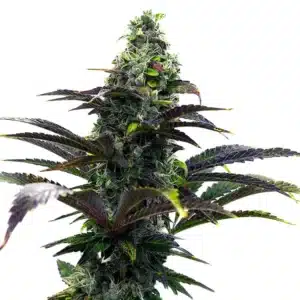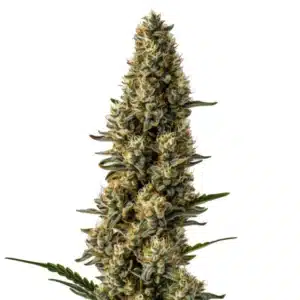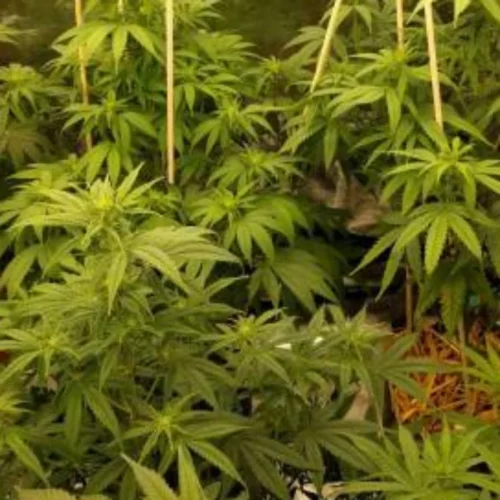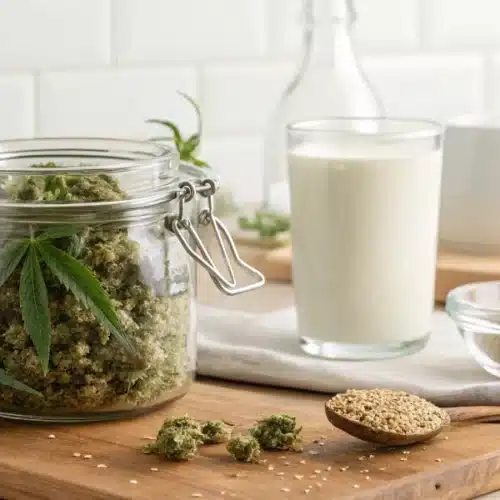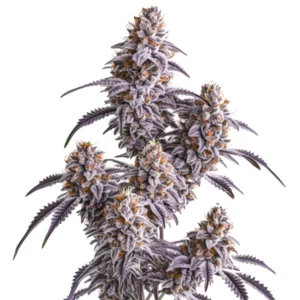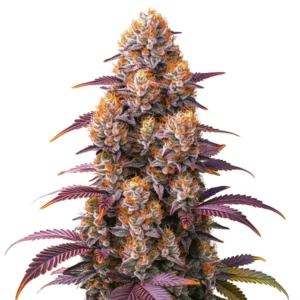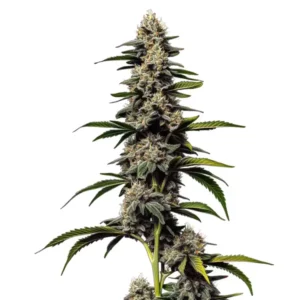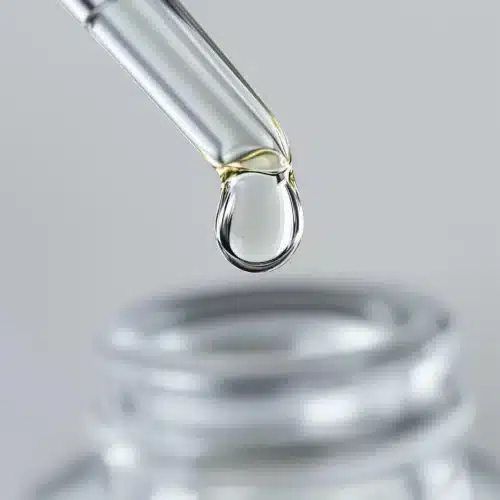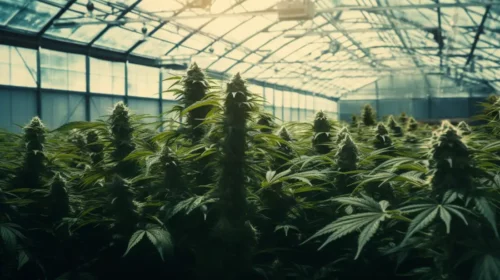When you start seeing brown spots or yellowing leaves on your cannabis plants, it’s more than just a small issue. These symptoms are early signs of bigger problems that can affect the entire harvest. Knowing how to identify, prevent, and treat cannabis leaf brown spots and yellowing is essential for any grower who wants a successful crop.
Why Are My Cannabis Leaves Turning Brown and Yellow?
Brown spots and yellowing can appear for several reasons, and they often tell you that something is off with your plants. As a grower, you need to act quickly. These signs could indicate nutrient deficiencies, pH imbalances, watering issues, or even pest infestations. Each problem requires a different approach, but with the right knowledge, you can fix the issue and bring your plants back to life.
Nutrient Deficiencies: Why Your Cannabis Leaves Are Suffering
When cannabis leaves start to show brown spots or yellowing, one of the first things to check is whether your plants are getting the right nutrients. Cannabis is a hungry plant, and without the correct balance of nitrogen, phosphorus, potassium, and micronutrients like magnesium and calcium, you’re bound to see your plants suffer.
Nitrogen deficiency, for example, is a common cause of yellowing leaves. When plants don’t get enough nitrogen, they can’t produce the chlorophyll they need for photosynthesis. You’ll see this as the yellowing of older leaves, which eventually turn brown and fall off.
On the other hand, potassium and phosphorus deficiencies often manifest as brown spots along the leaf edges. If not addressed early, these spots will grow, and the leaves will become brittle and dry.
Overfeeding: Don’t Kill Your Plants with Kindness
While nutrient deficiencies can cause cannabis leaf brown spots and yellowing, overfeeding can be just as deadly. Giving your plants too much of a good thing can result in nutrient burn, which shows up as crispy brown tips on your leaves. This burn can spread, causing the entire leaf to turn yellow and die.
The key here is balance. Always follow the recommended feeding schedule and keep an eye on how your plants respond. If you see signs of nutrient burn, flush your plants with clean water to remove excess salts and nutrients from the soil.
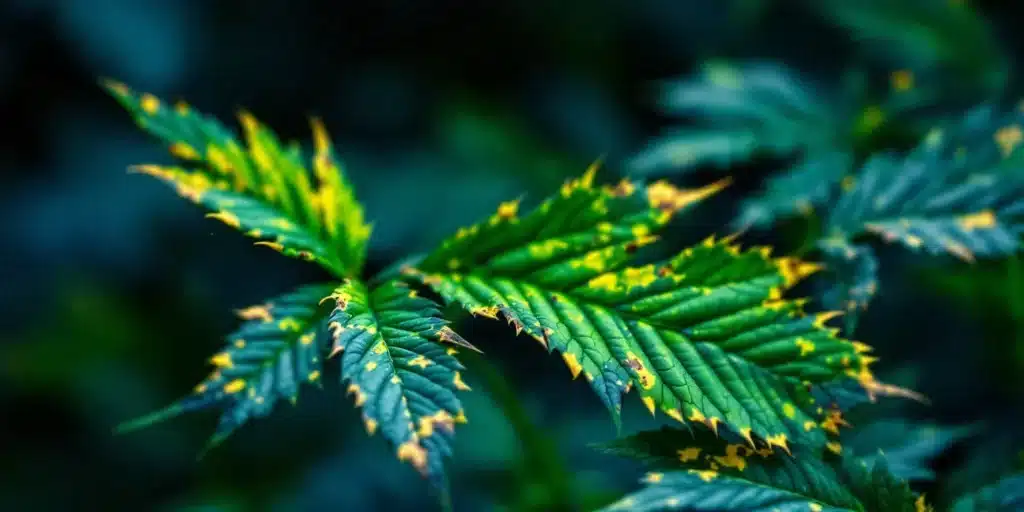
The pH Problem: How Imbalance Leads to Sick Plants
Even if you’re feeding your cannabis plants the right nutrients, they won’t be able to absorb them if the pH levels in the soil or water are off. Cannabis thrives in a specific pH range between 6.0 and 7.0 for soil and 5.5 to 6.5 for hydroponic setups. Anything outside of this range will lock out nutrients, leading to deficiencies and, you guessed it, cannabis leaf brown spots and yellowing.
If the pH is too high or too low, the nutrients become unavailable to your plants. This problem can lead to symptoms like yellowing leaves or brown spots that mimic a nutrient deficiency but are actually caused by poor pH management.
Promos & Deals
How to Fix Cannabis Leaf Brown Spots and Yellowing
Now that you know what might be causing your cannabis leaves to turn brown and yellow, it’s time to fix the problem. Early detection is key to preventing long-term damage, and with the right steps, you can save your plants before it’s too late.
Fixing Nutrient Deficiencies: Nitrogen, Potassium, and Phosphorus
If you suspect a nutrient deficiency, the first step is to correct it by providing the necessary nutrients. Nitrogen deficiency can be solved by using a high-quality nitrogen-rich fertilizer, while potassium and phosphorus deficiencies can be addressed with specialized supplements. Be careful not to overcompensate give your plants time to recover after feeding, and monitor their progress.
If you’re dealing with a nutrient lockout caused by pH imbalances, the solution is to flush your soil or hydroponic system with pH-balanced water. This will help remove the buildup of salts and restore the plant’s ability to absorb nutrients properly.
Overwatering vs. Striking the Right Balance
Watering is a delicate art in cannabis growing. Both overwatering and underwatering can cause serious problems, including brown spots and yellowing. Overwatered plants will show signs of root rot, which often starts as yellowing leaves. The leaves may also become droopy and develop brown, soggy spots as the roots suffocate from too much moisture.
On the flip side, underwatered plants will also yellow and develop brown, crispy patches on the leaves. In this case, the plant is unable to transport nutrients effectively because it lacks water. You can often tell the difference by checking the soil. If it’s bone dry, you need to water more often. If it’s constantly wet, scale back your watering routine.
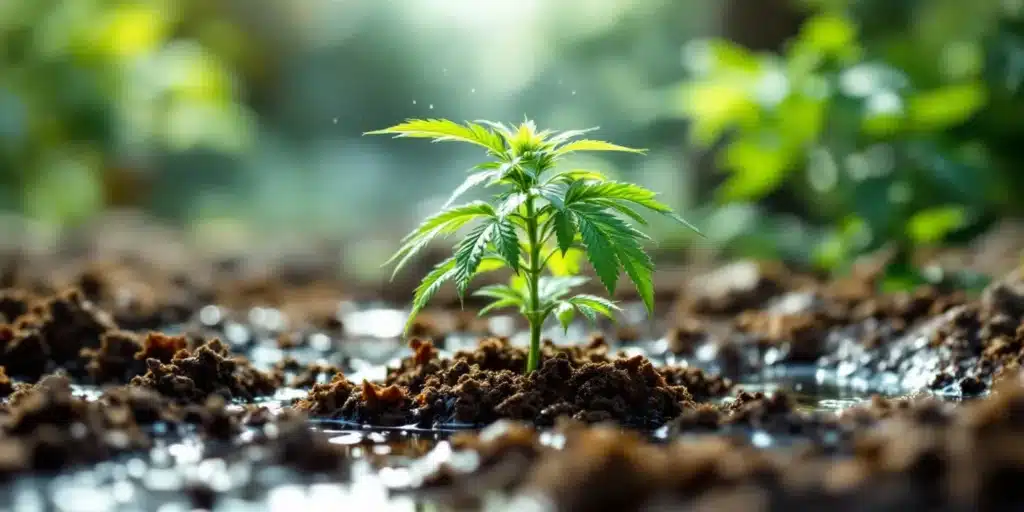
Environmental Factors Leading to Cannabis Leaf Discoloration
Beyond nutrients and water, your cannabis plants’ environment plays a huge function in their overall health. Factors like heat, light, and humidity can all contribute to cannabis leaf brown spots and yellowing if they aren’t properly controlled.
Heat Stress: Keeping Your Plants Cool
Cannabis plants love warmth, but too much heat can lead to stress, causing leaves to turn yellow or develop brown, crispy edges. If your grow space is too hot, your plants will struggle to transpire, leading to heat stress. This issue can be easily resolved by adjusting the temperature and improving ventilation to bring down the heat.
Light Burn: Don’t Overexpose Your Plants
It is essential for cannabis growth, but too much light can cause more harm than good. Light burn occurs when plants are placed too close to intense light sources, leading to yellowing or browning of the leaves, especially at the top of the plant. To prevent this, make sure your lights are positioned at the correct distance from your plants and consider using light meters to measure intensity.
Controlling Humidity for Healthier Cannabis Plants
Humidity levels can make or break your cannabis grow. Both high and low humidity can cause brown spots and yellowing in cannabis leaves. Cannabis plants need a specific range of humidity to thrive, typically between 40% and 60%, depending on the growth stage. If the humidity is too high, your plants become susceptible to fungal diseases like powdery mildew and bud rot. These diseases can cause yellowing and brown spots on the leaves, and if left untreated, they can spread throughout the plant, destroying your yield.
On the other hand, low humidity can cause your plants to lose moisture too quickly, leading to dry, crispy leaves with brown edges. This type of stress can severely stunt growth and reduce the plant’s ability to absorb nutrients properly. You can solve this issue by investing in a good hygrometer to monitor humidity levels and a humidifier or dehumidifier to adjust them as needed.
The Hidden Dangers of Pests and Diseases
Pests and diseases are another major cause of cannabis leaf brown spots and yellowing. Infestations can spread quickly, ruining entire crops if not dealt with promptly. Knowing the signs and how to handle common cannabis pests and diseases will save you from costly losses.
Spider Mites, Thrips, and Aphids: Tiny Pests, Big Damage
Spider mites, thrips, and aphids are among the most common pests that attack cannabis plants. These tiny insects feed on the plant’s sap, causing the leaves to turn yellow and develop brown or white spots. You’ll often notice webbing (in the case of spider mites) or tiny bugs crawling on the underside of the leaves.
Early detection is important. Regularly inspect your plants for signs of pests, and take immediate action if you find any. Organic insecticidal soaps, neem oil, or predatory insects like ladybugs can help you get rid of pests without harming your plants.
Fungal and Bacterial Infections: The Silent Killers
Fungal infections like powdery mildew and root rot can cause widespread damage, leading to yellowing leaves and brown spots. Powdery mildew appears as a white, powdery substance on the leaves, while root rot occurs when overwatered roots become infected by fungi, turning leaves yellow and brown as the disease spreads.
To prevent fungal infections, ensure good airflow and control the humidity levels in your grow space. Fungicides can be used to treat infected plants, but prevention is always the best approach.
Mastering pH Levels for Optimal Cannabis Growth
As mentioned earlier, pH plays a vital function in how your cannabis plants absorb nutrients. If the pH is off, even the best feeding schedule won’t save your plants from yellowing or brown spots. This makes pH management a top priority for growers who want to avoid cannabis leaf brown spots yellowing.
How pH Affects Nutrient Uptake
The pH level of your soil or water determines how easily your plants can access nutrients. In the wrong pH range, essential nutrients like nitrogen, phosphorus, and potassium become locked out, leaving your plants starved even though they have plenty of food available. This often leads to symptoms like yellowing leaves or brown spots, similar to a nutrient deficiency.
For soil grows, aim for a pH between 6.0 and 7.0. For hydroponic systems, the ideal pH range is slightly lower, between 5.5 and 6.5. Regularly check your pH levels using a digital pH meter to ensure your plants are in the optimal range.
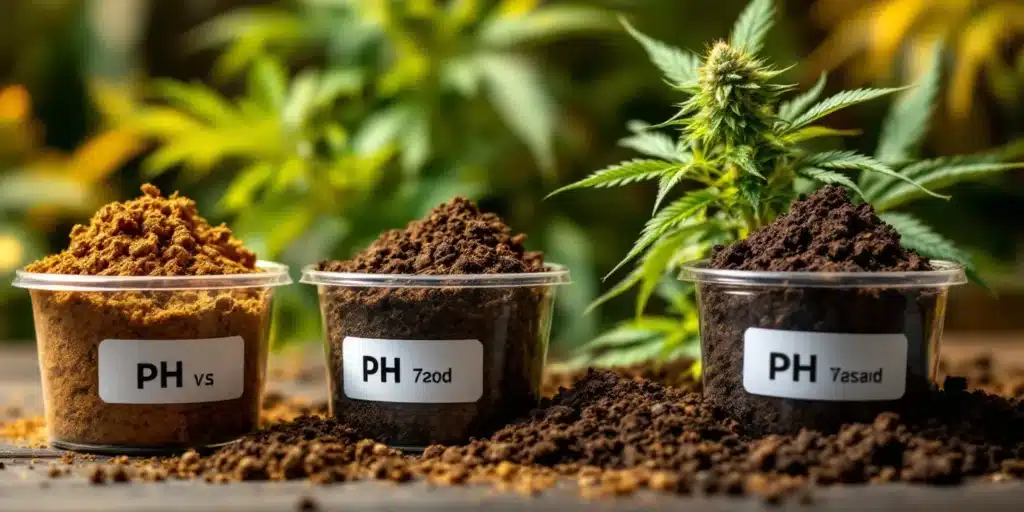
Testing and Adjusting pH Levels
Testing the pH of your soil or water is simple with the right tools. pH meters and test strips are readily available and easy to use. If you find that your pH is too high or too low, you can adjust it by adding pH up or pH down solutions to your water before feeding your plants.
A key tip: After adjusting the pH, give your plants a few days to recover before making any additional changes. Drastic shifts in pH can shock the plants, so gradual adjustments are best for maintaining balance.
Watering Mistakes That Lead to Cannabis Leaf Discoloration
One of the most common reasons for cannabis leaf brown spots and yellowing is improper watering. Too much or too little water can both lead to serious problems in your grow. Knowing the right balance is important for keeping your plants healthy and free from leaf discoloration.
Overwatering: A Silent Killer
Overwatering is one of the most frequent mistakes made by new growers. It’s easy to assume that more water means healthier plants, but cannabis roots need oxygen just as much as they need water. When the soil is constantly wet, it prevents oxygen from reaching the roots, leading to root rot. This shows up as yellowing leaves that eventually develop brown, soggy spots.
To avoid overwatering, make sure your pots have good drainage, and only water when the top inch of soil feels dry to the touch. A moisture meter can also help you keep track of when it’s time to water your plants.
Underwatering: Dehydrated and Stressed Plants
On the other end of the spectrum, underwatering can cause cannabis leaves to yellow and develop brown spots as well. When plants don’t get enough water, they struggle to transport nutrients, leading to deficiencies and stress. The leaves will turn yellow and develop brown, crispy edges.
The solution is to water your plants consistently. However, it’s essential not to overcorrect. If your plants have been underwatered, don’t drown them in water all at once. Gradually increase the amount you give them until they’re back on track.
How to Diagnose Cannabis Leaf Brown Spots and Yellowing
Diagnosing the exact cause of cannabis leaf brown spots and yellowing can be tricky, especially since many issues share similar symptoms. However, by following a systematic approach, you can pinpoint the root of the problem and take the necessary steps to correct it.
A Step-by-Step Diagnosis Process
Start by observing your plants closely. Look at the leaves, stems, and soil for any clues that might indicate nutrient deficiencies, pests, diseases, or environmental stress. Pay attention to where the discoloration occurs yellowing at the bottom of the plant often points to nitrogen deficiency, while brown spots on the leaf edges might indicate potassium deficiency or light burn.
Next, check your pH levels. This is a critical step, as pH imbalances are a common cause of nutrient lockout. Use a pH meter to test both your soil and your water. If the pH is off, adjust it accordingly before addressing any other potential issues.
Finally, inspect your watering routine and the environment. Make sure your plants are getting the right amount of water and that the temperature and humidity are within the optimal range for cannabis growth.
The Importance of Visual Symptoms in Cannabis Diagnosis
One of the most important tools you have as a cannabis grower is your ability to visually inspect your plants. Brown spots, yellowing, drooping, curling, and discoloration all provide valuable clues about your plant’s health. Learning to identify and interpret these symptoms is key to preventing problems before they spiral out of control.
Yellowing typically starts at the lower leaves if the plant is experiencing nitrogen deficiency, and the discoloration slowly moves upward. On the other hand, brown spots that develop at the tips or edges of the leaves are often caused by potassium deficiency or nutrient burn. Additionally, curling or twisting leaves could indicate heat stress or a severe pH imbalance.
By keeping a close eye on your plants and checking them regularly, you can catch early warning signs and take corrective measures before the damage becomes irreversible.
Using a pH Meter to Confirm Soil or Water Problems
Your visual diagnosis should always be confirmed with a pH meter. Often, cannabis leaf brown spots and yellowing are caused by pH imbalances that affect nutrient uptake. If your pH is outside the optimal range, even the most precise feeding schedule won’t help, as the plants simply cannot absorb the nutrients.
Using a pH meter is easy and quick. Simply test the runoff water from your pots or the water in your hydroponic system to get a reading. If the pH is too high or too low, adjust it slowly with pH up or pH down products until it’s within the proper range. This simple step can often resolve the issue entirely, preventing further leaf discoloration and keeping your plants thriving.

Preventing Brown Spots and Yellowing in Future Cannabis Grows
Preventing cannabis leaf brown spots and yellowing starts with knowing what causes these issues and taking proactive measures. As a grower, you’ll want to create an environment where your plants can thrive, free from the common stressors that lead to leaf discoloration.
Best Practices for Maintaining Nutrient Levels
The first step in prevention is to establish and maintain a consistent feeding schedule that provides all the necessary nutrients in balanced amounts. Too often, growers either overfeed or underfeed their plants, resulting in brown spots or yellowing.
Invest in a high-quality cannabis nutrient solution and follow the manufacturer’s guidelines. It’s also a good idea to use supplements like calcium and magnesium during the flowering stage to prevent deficiencies. Keep an eye on your plants for any signs of nutrient imbalances and adjust your feeding accordingly.
Regular pH Monitoring for Healthy Cannabis
As mentioned earlier, maintaining the correct pH is important for healthy cannabis growth. Regular pH testing should be part of your routine care. When you water your plants or feed them nutrients, always check the pH before applying it. Doing so ensures that your plants can absorb the nutrients they need without the risk of nutrient lockout.
Make it a habit to test the pH of your soil or hydroponic solution at least once a week, and make adjustments as necessary. This small step will prevent most nutrient deficiencies and help you avoid cannabis leaf brown spots and yellowing.
Controlling the Growing Environment: Light, Heat, and Humidity
Your cannabis plants’ environment plays a significant function in their overall health. Light, temperature, and humidity need to be carefully controlled throughout the growing cycle. Too much or too little of any of these factors can lead to stress, which often manifests as brown spots or yellowing leaves.
Ensure your plants receive the right amount of light without getting too close to the light source to avoid light burn. Temperature should be kept between 70°F and 85°F (21°C and 29°C), depending on the strain, while humidity should be monitored and adjusted based on the plant’s growth stage. During the vegetative stage, aim for 60% humidity, and during flowering, lower it to around 40-50% to prevent mold and mildew.
Routine Pest and Disease Inspections
Pests and diseases can strike quickly and devastate your crop if left unchecked. That’s why regular inspections are important. Set aside time each week to thoroughly inspect your plants for signs of pests like spider mites, thrips, or aphids, and look for any fungal infections like powdery mildew.
The earlier you catch these issues, the easier they are to manage. Neem oil, insecticidal soaps, and beneficial insects like ladybugs are all great natural options for pest control. For fungal diseases, maintaining proper airflow and humidity levels is your best defense.
Watering Your Plants the Right Way: Avoiding Root Issues
One of the easiest ways to avoid cannabis leaf brown spots and yellowing is to get your watering schedule right. Many growers make the mistake of either overwatering or underwatering their plants, both of which can lead to root problems and poor plant health.
Overwatering Prevention: The Key to Healthy Roots
As mentioned earlier, overwatering can lead to root rot and suffocate your plants by depriving the roots of oxygen. To avoid this, make sure your pots have proper drainage and that you’re not watering too frequently. A good rule of thumb is to water when the top inch of soil feels dry. This prevents soggy conditions that invite fungal diseases and lead to yellowing leaves and brown spots.
Proper Drainage: Why It’s Essential
Even if you have the perfect watering schedule, poor drainage can lead to standing water and soggy soil, causing root rot. To ensure your cannabis plants are getting proper drainage, use high-quality soil and pots with drainage holes. For added protection, consider placing a layer of pebbles or perlite at the bottom of your pots to help excess water escape quickly.
Keep Your Cannabis Plants Healthy: Avoiding Brown Spots and Yellowing
Maintaining a healthy cannabis grow requires diligence, attention to detail, and a commitment to monitoring your plants daily. Cannabis leaf brown spots and yellowing are warning signs that something in your setup needs to be adjusted, whether it’s your feeding schedule, pH levels, or the environment.
By following the steps outlined in this article, you’ll be well-equipped to prevent and address the causes of cannabis leaf brown spots and yellowing, ensuring that your plants stay healthy and produce a bountiful yield. Regular care, proper nutrient management, and a balanced environment will keep your cannabis plants thriving from seedling to harvest.
Let’s keep your plants in the best shape possible free from brown spots, yellowing leaves, and other stress factors that threaten your grow!


